Shu Wu
Beyond Artifacts: Real-Centric Envelope Modeling for Reliable AI-Generated Image Detection
Dec 24, 2025Abstract:The rapid progress of generative models has intensified the need for reliable and robust detection under real-world conditions. However, existing detectors often overfit to generator-specific artifacts and remain highly sensitive to real-world degradations. As generative architectures evolve and images undergo multi-round cross-platform sharing and post-processing (chain degradations), these artifact cues become obsolete and harder to detect. To address this, we propose Real-centric Envelope Modeling (REM), a new paradigm that shifts detection from learning generator artifacts to modeling the robust distribution of real images. REM introduces feature-level perturbations in self-reconstruction to generate near-real samples, and employs an envelope estimator with cross-domain consistency to learn a boundary enclosing the real image manifold. We further build RealChain, a comprehensive benchmark covering both open-source and commercial generators with simulated real-world degradation. Across eight benchmark evaluations, REM achieves an average improvement of 7.5% over state-of-the-art methods, and notably maintains exceptional generalization on the severely degraded RealChain benchmark, establishing a solid foundation for synthetic image detection under real-world conditions. The code and the RealChain benchmark will be made publicly available upon acceptance of the paper.
KBQA-R1: Reinforcing Large Language Models for Knowledge Base Question Answering
Dec 10, 2025Abstract:Knowledge Base Question Answering (KBQA) challenges models to bridge the gap between natural language and strict knowledge graph schemas by generating executable logical forms. While Large Language Models (LLMs) have advanced this field, current approaches often struggle with a dichotomy of failure: they either generate hallucinated queries without verifying schema existence or exhibit rigid, template-based reasoning that mimics synthesized traces without true comprehension of the environment. To address these limitations, we present \textbf{KBQA-R1}, a framework that shifts the paradigm from text imitation to interaction optimization via Reinforcement Learning. Treating KBQA as a multi-turn decision process, our model learns to navigate the knowledge base using a list of actions, leveraging Group Relative Policy Optimization (GRPO) to refine its strategies based on concrete execution feedback rather than static supervision. Furthermore, we introduce \textbf{Referenced Rejection Sampling (RRS)}, a data synthesis method that resolves cold-start challenges by strictly aligning reasoning traces with ground-truth action sequences. Extensive experiments on WebQSP, GrailQA, and GraphQuestions demonstrate that KBQA-R1 achieves state-of-the-art performance, effectively grounding LLM reasoning in verifiable execution.
Audio-Thinker: Guiding Audio Language Model When and How to Think via Reinforcement Learning
Aug 12, 2025Abstract:Recent advancements in large language models, multimodal large language models, and large audio language models (LALMs) have significantly improved their reasoning capabilities through reinforcement learning with rule-based rewards. However, the explicit reasoning process has yet to show significant benefits for audio question answering, and effectively leveraging deep reasoning remains an open challenge, with LALMs still falling short of human-level auditory-language reasoning. To address these limitations, we propose Audio-Thinker, a reinforcement learning framework designed to enhance the reasoning capabilities of LALMs, with a focus on improving adaptability, consistency, and effectiveness. Our approach introduces an adaptive think accuracy reward, enabling the model to adjust its reasoning strategies based on task complexity dynamically. Furthermore, we incorporate an external reward model to evaluate the overall consistency and quality of the reasoning process, complemented by think-based rewards that help the model distinguish between valid and flawed reasoning paths during training. Experimental results demonstrate that our Audio-Thinker model outperforms existing reasoning-oriented LALMs across various benchmark tasks, exhibiting superior reasoning and generalization capabilities.
DiffSpectra: Molecular Structure Elucidation from Spectra using Diffusion Models
Jul 09, 2025Abstract:Molecular structure elucidation from spectra is a foundational problem in chemistry, with profound implications for compound identification, synthesis, and drug development. Traditional methods rely heavily on expert interpretation and lack scalability. Pioneering machine learning methods have introduced retrieval-based strategies, but their reliance on finite libraries limits generalization to novel molecules. Generative models offer a promising alternative, yet most adopt autoregressive SMILES-based architectures that overlook 3D geometry and struggle to integrate diverse spectral modalities. In this work, we present DiffSpectra, a generative framework that directly infers both 2D and 3D molecular structures from multi-modal spectral data using diffusion models. DiffSpectra formulates structure elucidation as a conditional generation process. Its denoising network is parameterized by Diffusion Molecule Transformer, an SE(3)-equivariant architecture that integrates topological and geometric information. Conditioning is provided by SpecFormer, a transformer-based spectral encoder that captures intra- and inter-spectral dependencies from multi-modal spectra. Extensive experiments demonstrate that DiffSpectra achieves high accuracy in structure elucidation, recovering exact structures with 16.01% top-1 accuracy and 96.86% top-20 accuracy through sampling. The model benefits significantly from 3D geometric modeling, SpecFormer pre-training, and multi-modal conditioning. These results highlight the effectiveness of spectrum-conditioned diffusion modeling in addressing the challenge of molecular structure elucidation. To our knowledge, DiffSpectra is the first framework to unify multi-modal spectral reasoning and joint 2D/3D generative modeling for de novo molecular structure elucidation.
Reinforcing Spatial Reasoning in Vision-Language Models with Interwoven Thinking and Visual Drawing
Jun 11, 2025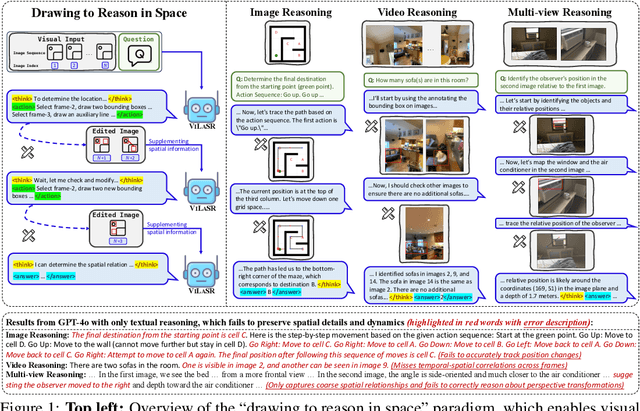
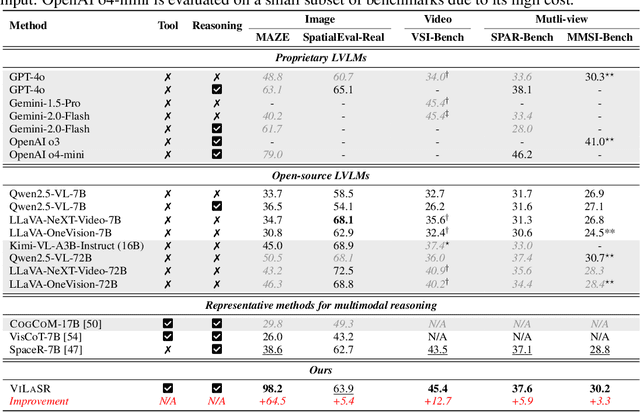


Abstract:As textual reasoning with large language models (LLMs) has advanced significantly, there has been growing interest in enhancing the multimodal reasoning capabilities of large vision-language models (LVLMs). However, existing methods primarily approach multimodal reasoning in a straightforward, text-centric manner, where both reasoning and answer derivation are conducted purely through text, with the only difference being the presence of multimodal input. As a result, these methods often encounter fundamental limitations in spatial reasoning tasks that demand precise geometric understanding and continuous spatial tracking-capabilities that humans achieve through mental visualization and manipulation. To address the limitations, we propose drawing to reason in space, a novel paradigm that enables LVLMs to reason through elementary drawing operations in the visual space. By equipping models with basic drawing operations, including annotating bounding boxes and drawing auxiliary lines, we empower them to express and analyze spatial relationships through direct visual manipulation, meanwhile avoiding the performance ceiling imposed by specialized perception tools in previous tool-integrated reasoning approaches. To cultivate this capability, we develop a three-stage training framework: cold-start training with synthetic data to establish basic drawing abilities, reflective rejection sampling to enhance self-reflection behaviors, and reinforcement learning to directly optimize for target rewards. Extensive experiments demonstrate that our model, named VILASR, consistently outperforms existing methods across diverse spatial reasoning benchmarks, involving maze navigation, static spatial reasoning, video-based reasoning, and multi-view-based reasoning tasks, with an average improvement of 18.4%.
LLM Unlearning Should Be Form-Independent
Jun 09, 2025Abstract:Large Language Model (LLM) unlearning aims to erase or suppress undesirable knowledge within the model, offering promise for controlling harmful or private information to prevent misuse. However, recent studies highlight its limited efficacy in real-world scenarios, hindering practical adoption. In this study, we identify a pervasive issue underlying many downstream failures: the effectiveness of existing unlearning methods heavily depends on the form of training samples and frequently fails to generalize to alternate expressions of the same knowledge. We formally characterize this problem as Form-Dependent Bias and systematically investigate its specific manifestation patterns across various downstream tasks. To quantify its prevalence and support future research, we introduce ORT, a novel benchmark designed to evaluate the robustness of unlearning methods against variations in knowledge expression. Results reveal that Form-Dependent Bias is both widespread and severe among current techniques. We argue that LLM unlearning should be form-independent to address the endless forms of downstream tasks encountered in real-world security-critical scenarios. Towards this goal, we introduce Rank-one Concept Redirection (ROCR), a novel training-free method, as a promising solution path. ROCR performs unlearning by targeting the invariants in downstream tasks, specifically the activated dangerous concepts. It is capable of modifying model parameters within seconds to redirect the model's perception of a specific unlearning target concept to another harmless concept. Extensive experiments demonstrate that ROCR significantly improves unlearning effectiveness compared to traditional methods while generating highly natural outputs.
Multi-MLLM Knowledge Distillation for Out-of-Context News Detection
May 28, 2025Abstract:Multimodal out-of-context news is a type of misinformation in which the image is used outside of its original context. Many existing works have leveraged multimodal large language models (MLLMs) for detecting out-of-context news. However, observing the limited zero-shot performance of smaller MLLMs, they generally require label-rich fine-tuning and/or expensive API calls to GPT models to improve the performance, which is impractical in low-resource scenarios. In contrast, we aim to improve the performance of small MLLMs in a more label-efficient and cost-effective manner. To this end, we first prompt multiple teacher MLLMs to generate both label predictions and corresponding rationales, which collectively serve as the teachers' knowledge. We then introduce a two-stage knowledge distillation framework to transfer this knowledge to a student MLLM. In Stage 1, we apply LoRA fine-tuning to the student model using all training data. In Stage 2, we further fine-tune the student model using both LoRA fine-tuning and DPO on the data points where teachers' predictions conflict. This two-stage strategy reduces annotation costs and helps the student model uncover subtle patterns in more challenging cases. Experimental results demonstrate that our approach achieves state-of-the-art performance using less than 10% labeled data.
Divide-Then-Align: Honest Alignment based on the Knowledge Boundary of RAG
May 27, 2025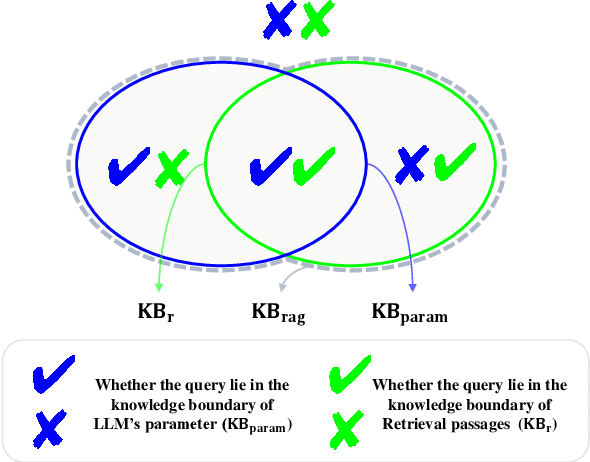
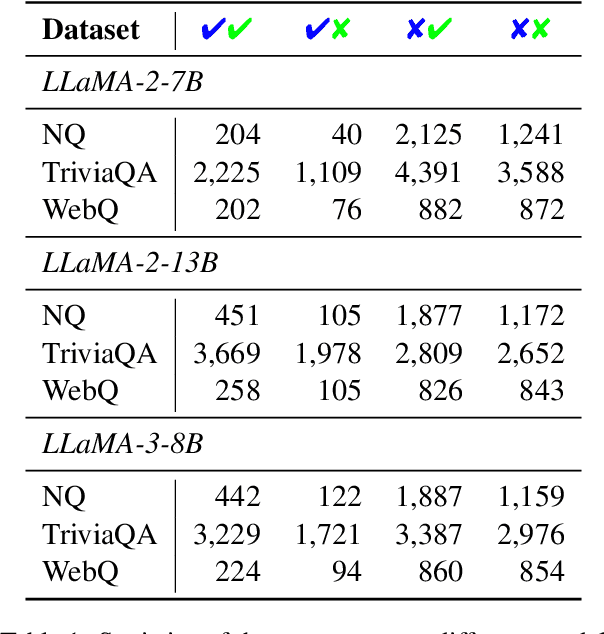
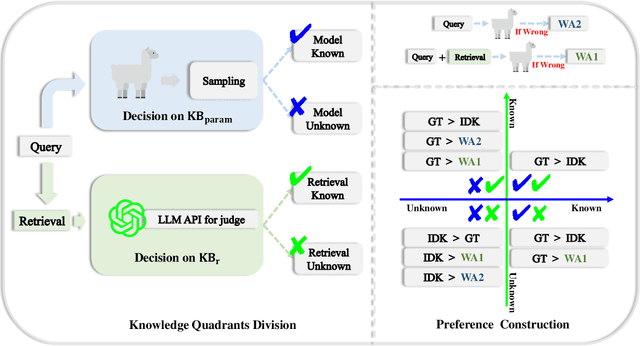
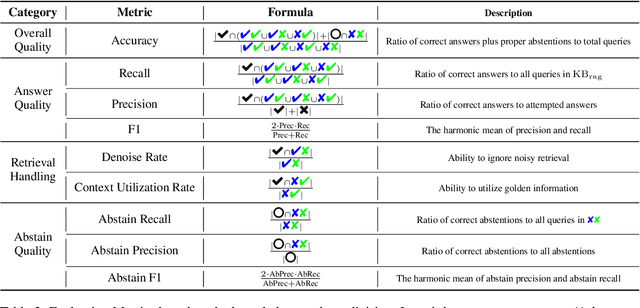
Abstract:Large language models (LLMs) augmented with retrieval systems have significantly advanced natural language processing tasks by integrating external knowledge sources, enabling more accurate and contextually rich responses. To improve the robustness of such systems against noisy retrievals, Retrieval-Augmented Fine-Tuning (RAFT) has emerged as a widely adopted method. However, RAFT conditions models to generate answers even in the absence of reliable knowledge. This behavior undermines their reliability in high-stakes domains, where acknowledging uncertainty is critical. To address this issue, we propose Divide-Then-Align (DTA), a post-training approach designed to endow RAG systems with the ability to respond with "I don't know" when the query is out of the knowledge boundary of both the retrieved passages and the model's internal knowledge. DTA divides data samples into four knowledge quadrants and constructs tailored preference data for each quadrant, resulting in a curated dataset for Direct Preference Optimization (DPO). Experimental results on three benchmark datasets demonstrate that DTA effectively balances accuracy with appropriate abstention, enhancing the reliability and trustworthiness of retrieval-augmented systems.
REACT: Representation Extraction And Controllable Tuning to Overcome Overfitting in LLM Knowledge Editing
May 25, 2025



Abstract:Large language model editing methods frequently suffer from overfitting, wherein factual updates can propagate beyond their intended scope, overemphasizing the edited target even when it's contextually inappropriate. To address this challenge, we introduce REACT (Representation Extraction And Controllable Tuning), a unified two-phase framework designed for precise and controllable knowledge editing. In the initial phase, we utilize tailored stimuli to extract latent factual representations and apply Principal Component Analysis with a simple learnbale linear transformation to compute a directional "belief shift" vector for each instance. In the second phase, we apply controllable perturbations to hidden states using the obtained vector with a magnitude scalar, gated by a pre-trained classifier that permits edits only when contextually necessary. Relevant experiments on EVOKE benchmarks demonstrate that REACT significantly reduces overfitting across nearly all evaluation metrics, and experiments on COUNTERFACT and MQuAKE shows that our method preserves balanced basic editing performance (reliability, locality, and generality) under diverse editing scenarios.
PoisonArena: Uncovering Competing Poisoning Attacks in Retrieval-Augmented Generation
May 18, 2025



Abstract:Retrieval-Augmented Generation (RAG) systems, widely used to improve the factual grounding of large language models (LLMs), are increasingly vulnerable to poisoning attacks, where adversaries inject manipulated content into the retriever's corpus. While prior research has predominantly focused on single-attacker settings, real-world scenarios often involve multiple, competing attackers with conflicting objectives. In this work, we introduce PoisonArena, the first benchmark to systematically study and evaluate competing poisoning attacks in RAG. We formalize the multi-attacker threat model, where attackers vie to control the answer to the same query using mutually exclusive misinformation. PoisonArena leverages the Bradley-Terry model to quantify each method's competitive effectiveness in such adversarial environments. Through extensive experiments on the Natural Questions and MS MARCO datasets, we demonstrate that many attack strategies successful in isolation fail under competitive pressure. Our findings highlight the limitations of conventional evaluation metrics like Attack Success Rate (ASR) and F1 score and underscore the need for competitive evaluation to assess real-world attack robustness. PoisonArena provides a standardized framework to benchmark and develop future attack and defense strategies under more realistic, multi-adversary conditions. Project page: https://github.com/yxf203/PoisonArena.
 Add to Chrome
Add to Chrome Add to Firefox
Add to Firefox Add to Edge
Add to Edge